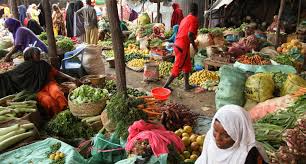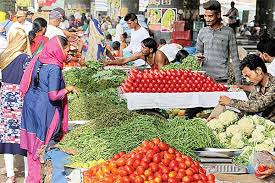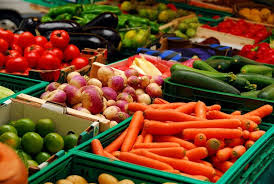Having learned about the characteristics of market structures in the previous article, it is necessary to learn about the types of market structures. This will help to appreciate the behavior and performance of participants in the agricultural market system.
1. Atomistic or Pure Competition in Agriculture
This is a situation where there are many firms on the seller side of the market that produce and sell a product which is standardized in the eyes of the buyers. A purely competitive market is also characterized as one that has virtually no barriers to entry or exit.
The level of market knowledge is used to distinguish between pure and perfect competition. Where the three characteristics mentioned above exist, it is a state of pure competition, but if in addition, there is the existence of full market knowledge or perfect market knowledge, it is called a perfect market or perfect competition.
The same term ‘Pure competition’ is used on the buyers’ side of the market where there are many buyers purchasing a standardized product. Atomistic competition is difficult to find in practical life situations, but the agricultural sector most closely illustrates it.
Read Also: How to know the Best Specie of Fish to Raise
2. Monopolistic and Monopsonistic Competition in Agricultural Markets

This is a situation where there are many firms selling differentiated products. It is a state of competition because many sellers are involved. The only difference between this and pure competition is in the nature of the product differentiated product.
The feed mills are typical examples of this market structure. There are many feed mills scattered all over Nigeria, but they all sell differentiated products as branded formula feeds and feed supplements.
What is meant by product differentiation? A product is said to be differentiated if it is a little bit different in the eyes of the buyers. The difference may be in the nature of the product, the quality of the product, or in such aspects as packaging, branding, or conditions of sale.
For example, Coca-Cola and Pepsi are both soft drinks, but they are different in the eyes of the buyers. They may differ in taste, the brand names are different, and the bottles are different.
The models of monopolistic and monopsonistic competition have the structural characteristics of (a) many buyers and many sellers, (b) product or service differentiation, and (c) relatively easy entry or exit.
Since the products are differentiated, it generally pays the firms to engage in merchandising (advertising), sales promotion, product and service improvement through research and development.
Product differentiation permits each firm to set its own price. Thus, a firm selling in a market under monopolistic competition is a “price marker,” not a “price taker.”
Read Also: The Most Lucrative between Production of Fish Fingerlings or Raising them to Table Size
3. Oligopolistic and Oligopsonistic Competition in Agriculture

This is the type of market structure in which few firms are engaged in buying and selling. If a few firms are engaged in selling a homogeneous product, this is referred to as purely oligopoly. On the other hand, a situation where a few firms are engaged in selling differentiated products is referred to as differentiated oligopoly.
On the buying side of the transaction, few firms or buyers buying a homogeneous product is referred to as pure oligopsony, and a situation where a few buyers buy differentiated products is referred to as differentiated oligopsony. In all cases of oligopoly or oligopsony, entry into the market is difficult and, in a few cases, virtually impossible.
Oligopolistic firms are price makers when they have differentiated products. Pricing tends to be a delicate issue in oligopoly market structure because of the fewness of firms participating in the market.
Thus, any foreseeable gain in the market share of one firm usually leads to a perceptible loss in the market share of one or more of its few competitors. Hence, any simple move by one firm, such as a price cut that erodes the market share of other rivals, will result in a price war.
One marked feature of the oligopoly market structure is the interdependence of the few buyers and sellers involved in the market. Such interdependence could lead to collusion. While interdependence may limit the managerial discretion of a firm, it could also provide marketing or procurement opportunities not available in competitive market structures.
These opportunities revolve around the fact that certain actions taken in recognition of mutual interdependence may benefit the whole group. Under this structure, it is common for a big firm among the few sellers, which has a larger proportion of the market share, to play the role of price leadership while the other firms follow suit.
Oligopolies with homogeneous products have nearly identical prices, while oligopolies with differentiated products may have a considerable variety of prices.
4. Pure Monopoly in Agriculture
This is a market structure in which there is a single firm selling a unique product. A monopoly is also characterized by completely blocked entry conditions and the continued effort to keep the market to itself. On the buyer’s side, a market structure in which there is a single buyer buying a unique product is called a monopsony market.
Monopsonies may exist in geographically restricted areas where there may be only one purchaser of farm products in certain highly dispersed farming areas. This one buyer thus has influence over the price paid to sellers.
A monopsonist can retain their position only by blocking the entry of other buyers into the market in which they operate. An example of a monopsonist in Nigeria was the defunct Cotton Board, which was the only body empowered by law to purchase and gin seed cotton produced in Nigeria.
Do you have any questions, suggestions, or contributions? If so, please feel free to use the comment box below to share your thoughts. We also encourage you to kindly share this information with others who might benefit from it. Since we can’t reach everyone at once, we truly appreciate your help in spreading the word. Thank you so much for your support and for sharing!
Read Also: Succulent Plants: A Guide to Growing and Caring for These Unique Plants






